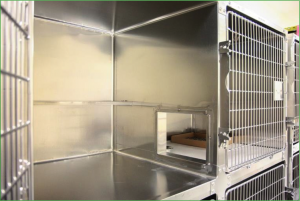1. Association of Shelter Veterinarians
The ASV is a critical resource for shelter veterinarians. It offers leadership, information and community. Membership is open to veterinarians and veterinary students. If you join only one organization, it should be this one.
2. ASV Guidelines for Standards of Care in Animal Shelters
In 2010, the ASV published the Guidelines for Standards of Care in Animal Shelters. Its impact has been enormous. The Guidelines cover physical, medical and behavioural needs of shelter animals, and are an essential resource for every animal shelter. They cover:
 The need for standards and the Five Freedoms for animal welfare
The need for standards and the Five Freedoms for animal welfare- Management and record keeping
- Facility design and environment
- Population management
- Sanitation
- Medical health and physical well-being
- Behavioural health and physical well-being
- Group housing
- Animal handling
- Euthanasia
- Spaying and neutering
- Animal transport
- Public health
The ASPCA and ASV have created a series of webinars, each highlighting a section of the Guidelines.
In 2013, a group of more than 40 individuals from 22 Canadian organizations reviewed and endorsed the ASV Guidelines. In the resulting Canadian Guidelines, the group adopted the ASV Guidelines in their entirety and added a list of relevant Canadian references, including position statements, guidelines and codes of practice.
3. A Paradigm Shift for Community Cats
The Community Cats initiatives, conceptualized and spearheaded by Dr. Kate Hurley from UC Davis, have revolutionized the way community cats (aka feral and stray cats) are viewed and managed by shelters, and have dramatically reduced incarceration, suffering and euthanasia for this population. The paradigm has shifted from a failed confine-and-euthanize approach to the more effective and humane strategy of population control through spay and neuter.
Part One of Dr. Hurley’s game-changing webinars explodes myths and assumptions about community cats and provides lifesaving alternatives for them. Part Two is a Q&A session on the subject. A must-watch for all shelter decision-makers.
 4. Double-compartment Housing for Cats
4. Double-compartment Housing for Cats
One of the most important changes a shelter can make for caged cats is to provide double-compartment, or “portalized” housing. This automatically results in reduced crowding, less stress, better welfare and less upper respiratory infection.
5. Animal Sheltering Magazine
Animal Sheltering is a bi-monthly publication of the Humane Society of the United States. It’s available online and in print. It’s unfailingly creative, progressive and motivating. Content covers all aspects of sheltering – such as intake diversion, servicing under-resourced communities, medical care, the well-being of shelter staff and individual stories that will touch your heart and inspire you to keep working for positive change and better outcomes.
